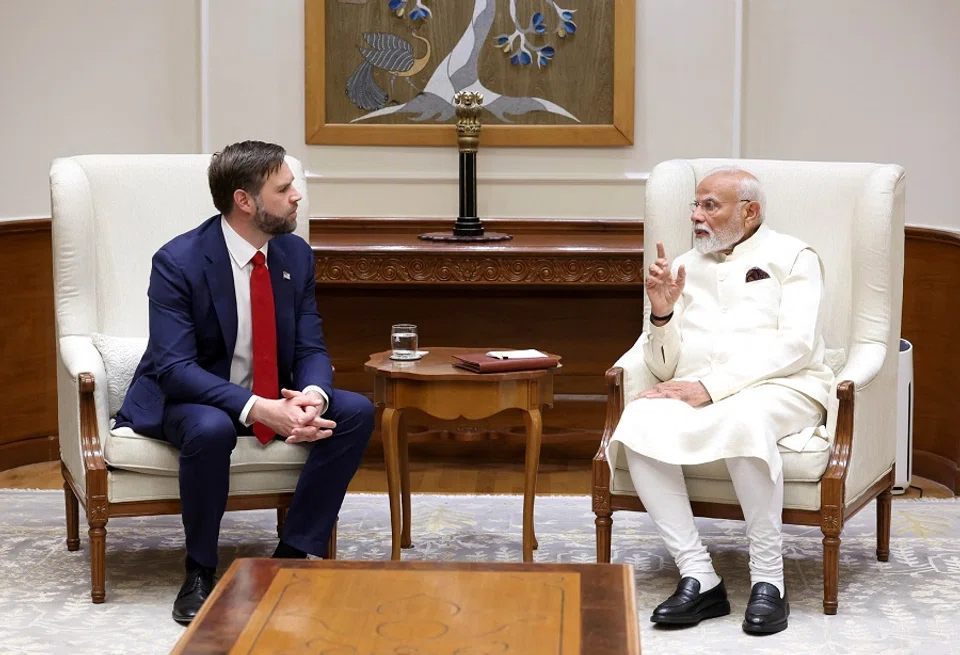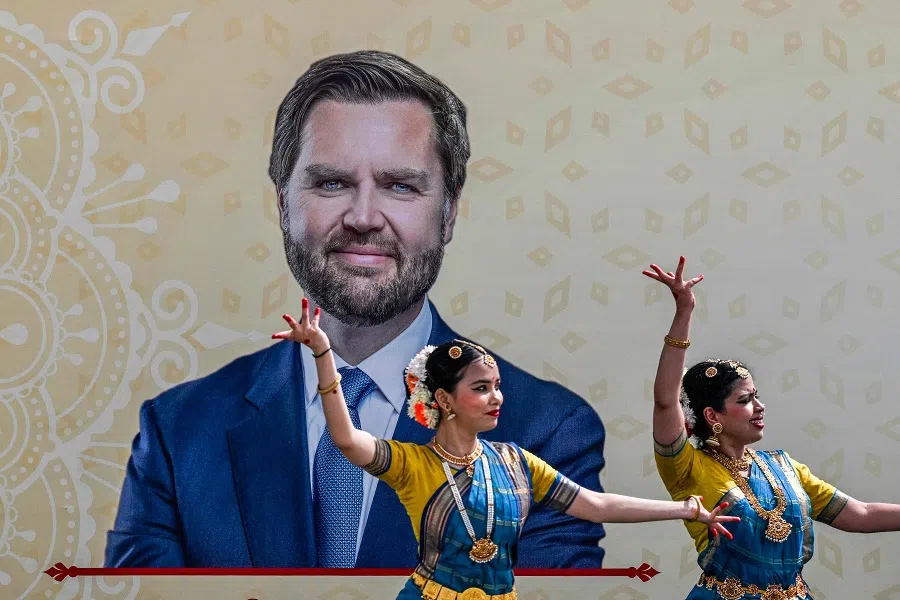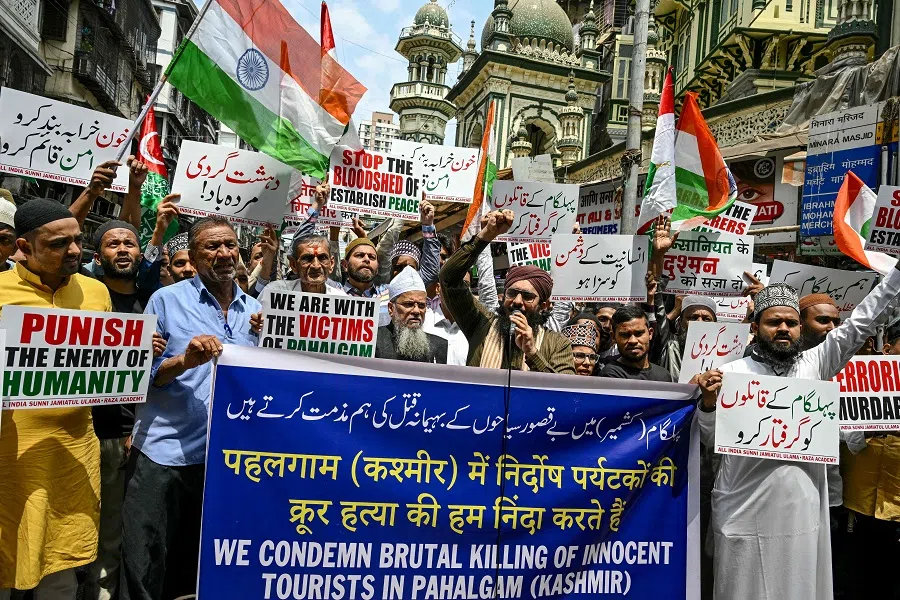JD Vance didn’t just visit India — he sent Beijing a message
US Vice-President JD Vance’s first official visit to India carried both symbolic and strategic messaging in the US’s bid to diversify supply chains, reduce dependence on China and strengthen partnerships with like-minded democracies. Indian academic Rishi Gupta analyses the situation.

As trade tensions between the US and China escalate following reciprocal tariffs and economic posturing, America’s growing engagement with India comes in the form of strategic recalibration, aiming to diversify supply chains, reduce dependence on China and strengthen partnerships with like-minded democracies.
Against this backdrop, Vice-President JD Vance’s first official visit to India from 21-24 April 2025 carried both symbolic and strategic messaging. Accompanied by his wife, Usha Vance, whose parents hail from India, and their three children, his four-day itinerary in India included cultural stopovers such as the Pink City of Jaipur and the iconic Taj Mahal in Agra — a fine blend of diplomacy with personal connection.
... owing to ideological differences — rooted in India’s socialist orientation and the influence of communist parties within coalition governments — India maintained a measured distance with the US...
‘Strategic partnership’ anchor of US-India relations
But let us begin with the timing of the visit — just two months after Indian Prime Minister Narendra Modi’s state visit to Washington in February this year. This underscored an intended and planned projection of deepening ties with India.
In the past, mainly during the Cold War Era, American support to Pakistan was a key reason that Delhi and Washington stood divided, and even if they interacted, there was a measured distance for much of the time. Similarly, owing to ideological differences — rooted in India’s socialist orientation and the influence of communist parties within coalition governments — India maintained a measured distance with the US — whose global ambitions often conflicted with Delhi’s non-aligned and inward-focused development model.
However, the relationship improved significantly in the early 1990s, as the Cold War ended and India initiated economic reforms, opening the door to greater diplomatic engagement and mutual cooperation. Further, India’s ideologically driven foreign policy has changed over the past two decades on both sides, with cooperation in the “war on terror” marking the beginning of collaboration, followed by nuclear cooperation in the civilian sector.

Today, strategic partnership remains at the core of the relationship, which is often driven by mutual challenges like China’s growing presence in the Indo-Pacific region. President Trump initiated some of it during his first tenure, like the Quadrilateral Security Dialogue (Quad), by bringing India, Australia and Japan on board. Delhi also enjoyed a greater understanding with the Biden administration. However, there are a few things that Trump 2.0 is doing differently with India.
By addressing a significant concern that Delhi faced with the US — attack on the sociocultural and political fabric of India — Vance may have just done something that the previous administrations saw as impossible.
JD Vance’s trip helped build trust
Strategic ties from core ideological differences were still an area of unease, mainly for India, as it often saw the US using human rights and democratic downgrading for tactical benefits. But Vice-President JD Vance seems to have resolved it by saying, “Too often in the past, Washington approached PM Modi with an attitude of preachiness, or even condescension.” He further highlighted that President Trump envisions the relationship with India on equal terms.
By addressing a significant concern that Delhi faced with the US — attack on the sociocultural and political fabric of India — Vance may have just done something that the previous administrations saw as impossible. For instance, in 2024, India strongly objected to the remarks of the US State Department spokesperson about certain legal proceedings in India. Vance also acknowledged India as a vibrant democracy, calling Modi’s government “arguably the most popular in the democratic world”. To simplify, the Trump administration sees trust and respect for a partnership like India as the bare minimum for deeper cooperation to flourish in the region.
While India’s partnership under Trump 2.0 was expected to see a tectonic shift, after the tariffs were announced, President Trump continued mentioning India for imposing high tariffs on incoming American goods, and that the US goods trade deficit with India was US$45.7 billion in 2024. Interestingly, unlike China, India has not been reactive to the reciprocal tariffs — something Washington, DC, seems to appreciate, contributing to positive negotiations on finalising a bilateral trade agreement.
Together against terrorism
India was shaken by a massive terror attack in the Kashmir Valley on 22 March, where terrorists killed 26 civilians, who were out on a vacation. President Trump was quick in condemning the attacks on his Truth Social account, saying: “Deeply disturbing news out of Kashmir. The United States stands strong with India against Terrorism. We pray for the souls of those lost, and for the recovery of the injured. Prime Minister Modi, and the incredible people of India, have our full support and deepest sympathies. Our hearts are with you all!”

JD Vance, too, in a post on X, said, “Usha and I extend our condolences to the victims of the devastating terrorist attack in Pahalgam, India. Over the past few days, we have been overcome with the beauty of this country and its people. Our thoughts and prayers are with them as they mourn this horrific attack.” The Indian media quickly picked this up, terming it a significant support while listing international support from the global community.
Notably, the White House spokesperson referred to India as “our ally” while extending condolences to the victims of the 22 March terror attack in Kashmir. Though India officially identifies as non-aligned and prefers the term “partner” over “ally” — a term more rooted in America’s treaty-based alliances — this shift in language may not be too bad, as it could signal a growing American willingness to treat India’s security concerns as aligned with broader shared strategic understanding on terrorism.
Since the abrogation of Article 370 in 2019, which granted special status to Jammu and Kashmir, the Modi government has focused on normalising the region through increased tourism and stability, countering decades of Pakistan-sponsored militancy and cross-border terrorism rooted in a historical border dispute. Although militancy has remained relatively low under Modi’s administration, such barbaric episodes often revive some of the darkest memories.
His focus on shared goals in defence, energy, and AI signals a clear intent to deepen integration among Quad members, turning the partnership into a functional alliance capable of responding to regional threats.
Noteworthy, terrorism remains a key challenge for both India and the US, which have faced its devastating consequences for the longest. What was 9/11 for the US, India witnessed 26/11 when hundreds of civilians, including foreigners, were killed by Pakistani terrorists in Mumbai in 2008. Both attacks had a common connection — Pakistan. While Osama Bin Laden, mastermind of the 9/11 attacks in the US, was found in Pakistan, the 26/11 mastermind Hafiz Saeed still roams the streets of Pakistan.
For the recent attacks in Kashmir, India has accused Pakistan.

Meanwhile, the extradition of Tahawwur Rana — a key conspirator in the 26/11 attacks — from the US to India reflects not just rhetorical alignment but a growing commitment to action, signalling a more coordinated and resolute approach by both democracies in countering terrorism.
Tackling China together — a common ‘foreign adversary’
Vance’s visit also served as a subtle but strategically strong message for the “foreign adversary” — without naming China. At a public event in India’s city of palaces, Jaipur, Vance spoke on Quad, reinforcing that the grouping is a strategic bulwark against coercive regional powers. He highlighted that “India, this year, is hosting the Quad Leaders’ Summit this fall,” framing New Delhi’s role as more than symbolic — as a pivot for shaping Indo-Pacific security. His focus on shared goals in defence, energy, and AI signals a clear intent to deepen integration among Quad members, turning the partnership into a functional alliance capable of responding to regional threats.
... while Beijing seeks new trade allies in response to American tariffs, Washington is placing New Delhi at the centre of its Asia rebalance.
Further, in Vance’s vision, the Quad is “a shared goal for all of us in this room” and serves not merely as a diplomatic forum but as a means to operationalise collective deterrence and uphold a free, open, and rules-based Indo-Pacific — a subtle but direct counter to China.
Also, while Beijing seeks new trade allies in response to American tariffs, Washington is placing New Delhi at the centre of its Asia rebalance. Therefore, Vance’s blend of personal outreach and geopolitical messaging suggests that India will play an increasingly pivotal role in America’s Indo-Pacific calculus.
To conclude, a defence-focused partnership between India and the US has been more engaging in recent years since the 2020 border conflict between India and China. The prospect of co-producing advanced military systems like the F-35s and autonomous maritime technologies underscores a strategic shift where India is now invited to move beyond traditional arms buyers and into the elite tier of US defence partners. This could be seen as a deterrent “through mutual strength” against what he calls “foreign aggressors”, but it needs little guessing who.





